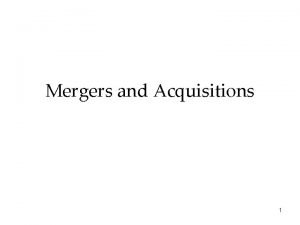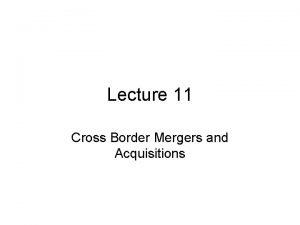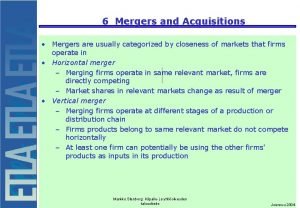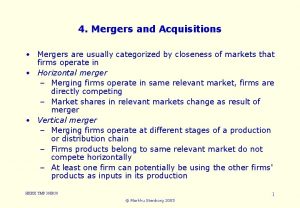Mergers Acquisitions and Takeovers What are the Differences












- Slides: 12

Mergers, Acquisitions, and Takeovers: What are the Differences? • Merger Ø A strategy through which two firms agree to integrate their operations on a relatively co-equal basis • Acquisition Ø A strategy through which one firm buys a controlling, or 100% interest in another firm with the intent of making the acquired firm a subsidiary business within its portfolio • Takeover Ø A special type of acquisition when the target firm did not solicit the acquiring firm’s bid for outright ownership Copyright © 2004 South-Western. All rights reserved. 1

Adapted from Figure 7. 1 Reasons for Acquisitions Cost new product development/increased speed to market Increased diversification Acquisitions Increased market power Overcoming entry barriers Avoiding excessive competition Lower risk compared to developing new products Copyright © 2004 South-Western. All rights reserved. Learning and developing new capabilities 2

Market Power Acquisitions Horizontal Acquisitions • Acquisition of a company in the same industry in which the acquiring firm competes increases a firm’s market power by exploiting: Ø Cost-based synergies Ø Revenue-based synergies • Acquisitions with similar characteristics result in higher performance than those with dissimilar characteristics Copyright © 2004 South-Western. All rights reserved. 3

Market Power Acquisitions (cont’d) Horizontal Acquisitions Vertical Acquisitions • Acquisition of a supplier or distributor of one or more of the firm’s goods or services Copyright © 2004 South-Western. All rights reserved. Ø Increases a firm’s market power by controlling additional parts of the value chain 4

Market Power Acquisitions (cont’d) Horizontal Acquisitions • Acquisition of a company in a highly related industry Vertical Acquisitions Ø Because of the difficulty in implementing synergy, related acquisitions are often difficult to implement Related Acquisitions Copyright © 2004 South-Western. All rights reserved. 5

Adapted from Figure 7. 1 Too large Problems in Achieving Success Acquisitions Too much diversification Integration difficulties Inadequate evaluation of target Managers overly focused on acquisitions Large or extraordinary debt Copyright © 2004 South-Western. All rights reserved. Inability to achieve synergy 6

Attributes of Successful Acquisitions Table 7. 1 Copyright © 2004 South-Western. All rights reserved. 7

Restructuring • A strategy through which a firm changes its set of businesses or financial structure Ø Failure of an acquisition strategy often precedes a restructuring strategy Ø Restructuring may occur because of changes in the external or internal environments • Restructuring strategies: Ø Downsizing Ø Downscoping Ø Leveraged buyouts Copyright © 2004 South-Western. All rights reserved. 8

Types of Restructuring: Downsizing • A reduction in the number of a firm’s employees and sometimes in the number of its operating units Ø May or may not change the composition of businesses in the company’s portfolio • Typical reasons for downsizing: Ø Expectation of improved profitability from cost reductions Ø Desire or necessity for more efficient operations Copyright © 2004 South-Western. All rights reserved. 9

Types of Restructuring: Downscoping • A divestiture, spin-off or other means of eliminating businesses unrelated to a firm’s core businesses • A set of actions that causes a firm to strategically refocus on its core businesses Ø May be accompanied by downsizing, but not eliminating key employees from its primary businesses Ø Firm can be more effectively managed by the top management team Copyright © 2004 South-Western. All rights reserved. 10

Restructuring: Leveraged Buyouts • A restructuring strategy whereby a party buys all of a firm’s assets in order to take the firm private Ø Significant amounts of debt are usually incurred to finance the buyout • Can correct for managerial mistakes Ø Managers making decisions that serve their own interests rather than those of shareholders • Can facilitate entrepreneurial efforts and strategic growth Copyright © 2004 South-Western. All rights reserved. 11

Restructuring and Outcomes Adapted from Figure 7. 2 Copyright © 2004 South-Western. All rights reserved. 12
 Aqa merger of
Aqa merger of Radiology mergers and acquisitions
Radiology mergers and acquisitions Hr issues in mergers and acquisitions
Hr issues in mergers and acquisitions Franchise mergers & acquisitions advisors
Franchise mergers & acquisitions advisors Define corporate restructuring
Define corporate restructuring Mergers in strategic management
Mergers in strategic management Mergers and acquisitions rumors
Mergers and acquisitions rumors Non equity alliance
Non equity alliance What is mergers and acquisitions
What is mergers and acquisitions Duncan forbes hr
Duncan forbes hr Mikael ferm
Mikael ferm Hostile takeover short-termism
Hostile takeover short-termism Corporations mergers and multinationals
Corporations mergers and multinationals























